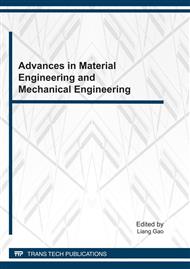p.23
p.28
p.33
p.39
p.45
p.51
p.55
p.61
p.67
Simulation for Fatigue Crack Propagation Behavior Based on Low Cycle Fatigue Critical Damage
Abstract:
Based on low cycle fatigue critical damage, a numerical procedure for predicting stable fatigue crack propagation behavior of materials and structures was developed, which was named as LFF (LCF: Low Cycle Fatigue + FCP: Fatigue Crack Propagation + FEA: Finite Element Analysis) in this work. In the LFF method, stress and strain amplitude of nodes located at the plastic zone in the crack growing direction and fatigue damage of these nodes were firstly computed from a finite element code ANSYS. Then, by assuming a discontinuous step of propagation in the process of fatigue crack propagation, the stable fatigue crack propagation behavior of materials and structures could be estimated. Experiments on low cycle fatigue and fatigue crack propagation for Cr2Ni2MoV, TA12 and TC4 alloys were employed to certificate the applicability and validity of the LFF method. The results show that the LFF method is suitable for the estimation of stable fatigue crack propagation of a CT specimen with a straight crack under mode Ⅰloading and with a slant crack under mixed mode Ⅰ and Ⅱ loading.
Info:
Periodical:
Pages:
45-50
Citation:
Online since:
July 2011
Authors:
Price:
Сopyright:
© 2011 Trans Tech Publications Ltd. All Rights Reserved
Share:
Citation:


